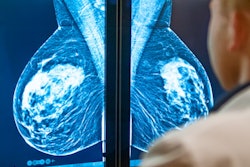
Mammography care coordination by U.S. Department of Veterans Affairs (VA) medical centers is perceived as inefficient due to coordination challenges with outside facilities, a study published December 15 in Women's Health Issues found.
Researchers led by Gillian Monty from the VA Puget Sound Health Care System in Seattle found in qualitative interviews with VA breast imaging staff that "nearly all participants" negatively described the coordination process. They added that challenges come from variability in community provider processes and their limited understanding of VA processes -- issues that can negatively impact veterans.
"Coordinating community care mammograms is challenging for staff across multiple VA departments and roles," Monty and colleagues wrote. "Effective communication within VA and developing clear roles and responsibilities for VA staff, including establishing point people in key departments, can help facilitate coordination."
The VA looks to outside facilities to provide mammograms for most patients. Previous studies suggest there are challenges in coordination between VA centers and other healthcare systems for some sex-specific services. However, researchers noted that little is known about barriers and facilitators to such mammogram care coordination.
The Monty team wanted to describe coordination processes for mammograms referred outside of VA centers. They also sought to characterize VA staff perspectives on care coordination barriers and facilitators through qualitative interviews.
In total, the researchers interviewed 44 VA staff members at 10 VA medical centers that refer all mammograms outside of the VA. The centers have a combined total of 10,113 women veterans as of 2020. The total number of completed community mammogram consults among these sites is 1,821.
Respondents included staff across multiple VA departments involved in coordinating mammograms, including program leaders and care coordinators, primary care nurses and providers, radiology administrative staff, and community care supervisors among others.
The researchers found variability in how care coordination process steps are achieved, and identified six themes in their interviews:
- The process is generally perceived as inefficient.
- Clarity in VA staff roles and responsibilities is needed.
- Internal VA communication makes way for coordination.
- Challenges come from variability in community provider processes and their limited understanding of VA processes.
- Coordination challenges can negatively impact veterans.
- Technology remains a barrier, despite showing promise.
"With a few notable exceptions, key informants across all role types expressed frustration with existing coordination processes for mammograms referred to the community," the researchers wrote. They added that words such as "cumbersome," "inefficient," "clunky," and "prone to errors" were used to describe the process.
The study findings suggest that VA sites could consider investing in more health information technology to ease mammogram care coordination, as well as resources in education and technical assistance. The authors also suggested that centers should consider designating staff with mammogram coordination expertise within each involved VA department. This includes regular meetings among interdepartmental stakeholders for better communication and collaboration.
"Non-VA facilities also may benefit from establishing a point person for coordinating mammogram records exchanges with referring facilities," the researchers concluded.



















